Dodge Journey: Disassembly, Assembly
Disassembly
NOTE: Before disassembling the brake caliper, remove it from the vehicle.
NOTE: Before disassembling the brake caliper, clean and inspect it.
WARNING: Under no condition should high pressure air ever be used to remove a piston from a caliper bore. Personal injury could result from such a practice.
CAUTION: Do not use excessive force when clamping caliper in vise. Excessive vise pressure will cause bore distortion.
1. Mount the caliper in a vise equipped with protective jaws.
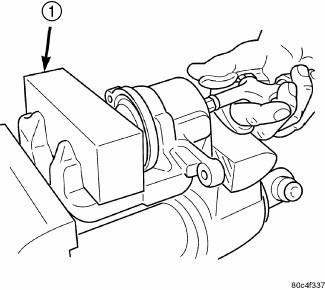
Fig. 60: Piston Removal
- - WOOD BLOCK
WARNING: Do not place face or hands near caliper and piston if using compressed air pressure to remove piston. Do not use high pressure.
2. Place a wooden block (1) in the caliper as shown.
3. If necessary, apply low pressure compressed air to the caliper fluid inlet in short spurts to force the piston out.
4. Remove the piston from the caliper.
5. Remove the dust boot from the piston and discard it.
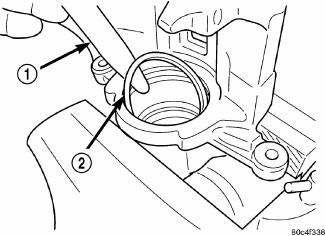
Fig. 61: Piston Seal Removal
- - TRIM STICK
- - SEAL
CAUTION: Do not use a screw driver or other metal tool for seal removal. Using such tools can scratch the bore or leave burrs on the seal groove edges.
6. Using a soft tool such as a plastic trim stick (1), work the piston seal (2) out of its groove in caliper piston bore. Discard the used seal.
7. Clean the piston bore and drilled passage ways with alcohol or a suitable solvent. Wipe it dry using only a lint-free cloth.
8. Inspect both the piston and bore for scoring or pitting. Bores that show light scratches or corrosion can usually be cleared of the light scratches or corrosion using crocus cloth.
CLEANING
WARNING: Chrysler LLC does not manufacture any vehicles or replacement parts that contain asbestos. Aftermarket products may or may not contain asbestos. Refer to aftermarket product packaging for product information.
Whether the product contains asbestos or not, dust and dirt can accumulate on brake parts during normal use. Follow practices prescribed by appropriate regulations for the handling, processing and disposing of dust and debris.
To clean or flush the internal passages of the brake caliper, use fresh brake fluid or Mopar Non-Chlorinated Brake Parts Cleaner. Never use gasoline, kerosene, alcohol, oil, transmission fluid or any fluid containing mineral oil to clean the caliper. These fluids will damage rubber cups and seals.
INSPECTION
Inspect the disc brake caliper for the following:
- Brake fluid leaks in and around piston boot area
- Ruptures, brittleness or damage to the piston dust boot
If caliper fails inspection, disassemble and recondition caliper, replacing the seals and dust boots.
Assembly
NOTE: Always have clean hands when assembling a brake caliper.
NOTE: Always use fresh, clean brake fluid when assembling a brake caliper.
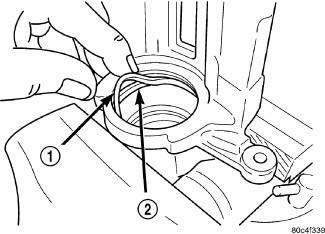
Fig. 62: New Piston Seal Installation
- - SEAL
- - GROOVE
NOTE: Never use an old piston seal.
1. Dip the NEW piston seal in clean brake fluid and install it in the groove (2) of the caliper bore. The seal (1) should be started at one area of the groove and gently worked around into the groove using only your clean fingers to seat it.
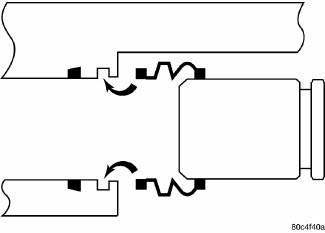
Fig. 63: Boot Installation
2. Coat the NEW piston with clean brake fluid.
3. Coat the NEW piston boot with clean brake fluid leaving a generous amount inside the boot.
4. Position the dust boot over the lower section of the piston.
5. Extend the dust boot below the bottom of the piston and guide the lip seal into the groove in the caliper piston bore.
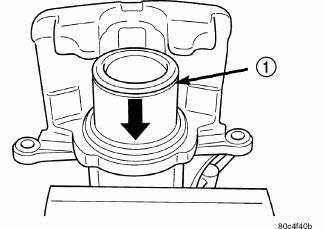
Fig. 64: Piston Installation
- - PISTON GROOVE
CAUTION: Force applied to the piston (1) to seat it in the bore must be applied uniformly to avoid cocking and binding of the piston.
6. Install the piston (1) into the bore, carefully pushing it past the piston seal using hand pressure . Push the piston in until it bottoms in the caliper bore and the dust boot lip seal falls into the groove near the top of the piston.
7. Install the caliper on the vehicle and bleed the brakes as necessary.
 Removal
Removal
Fig. 56: BRAKE PEDAL HOLDING TOOL
1. Using a brake pedal holding tool as shown, depress the brake pedal past
its first one inch (25 mm) of
travel and hold it in this position. This will isolate ...
 Installation
Installation
1. Completely retract the caliper piston back into the bore of the caliper.
Use a C-clamp to retract the piston.
Place a wood block over the piston before installing the C-clamp to avoid
damagi ...
See also:
Holding clutches
DESCRIPTION
Fig. 356: Identifying 2/4 & Low/Reverse Clutches & Planetary Geartrain
Components
- FRONT PLANET CARRIER/REAR ANNULUS
- 2/4 CLUTCH
- L/R CLUTCH
- REAR PLANET CARRIER ...
Description, Operation
DESCRIPTION
POWERTRAIN CONTROL MODULE (PCM)
The Powertrain Control Module (PCM) is a digital computer containing a
microprocessor. The PCM receives
input signals from various switches and sensors ...
IF YOU NEED ASSISTANCE
The manufacturer and its authorized dealers are vitally
interested in your satisfaction. We want you to be happy
with our products and services.
Warranty service must be done by an authorized deale ...
